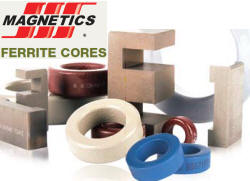|
 After
recently reading a few articles on ferromagnetic materials
for both power supply and RF balun use, I did a little research to find some good sources for information. This
table of parameters on common soft magnetic materials is derived from a page in a whitepaper on the
Magnetics website. The paper contrasts properties of powdered magnetics, which are composed almost totally of
ferrous metal (iron, nickel, cobalt, manganese, et al), versus ferrites, which are
a mix of ferrous metal and oxides. After
recently reading a few articles on ferromagnetic materials
for both power supply and RF balun use, I did a little research to find some good sources for information. This
table of parameters on common soft magnetic materials is derived from a page in a whitepaper on the
Magnetics website. The paper contrasts properties of powdered magnetics, which are composed almost totally of
ferrous metal (iron, nickel, cobalt, manganese, et al), versus ferrites, which are
a mix of ferrous metal and oxides.
The following table of data listing properties of soft magnetic materials was derived from a "A
Critical Comparison of Ferrites with Other Magnetic Materials," on the Magnetics™ website.
Definitions of parameters are as follows:
- Initial Permeability: ratio between the field B (induction) and the field
H (A/m during magnetization) measured when
the
field H is close to zero.
- Bmax: Saturation Flux Density = maximum flux density that a magnetic material can accommodate;
beyond
Bmax, further increases
in H result in no significant increase in B.
- Loss Coefficients: e = eddy current, a = hysteresis coefficient, c = residual loss
- Curie Temperature: temperature at which a ferromagnetic material loses its ferromagnetism and becomes
paramagnetic
(μe approaches 1).
- μ0 x Q: figure of merit (product of μ and Q) for linear core
materials. At frequencies of 100 kHz and above,
the
value for ferrites is considerably above all other materials.
| Fe |
250 |
22 |
- |
- |
- |
770 |
10 · 10-6 |
- |
60-1,000 Hz |
| Si-Fe (unoriented) |
400 |
20 |
870 |
120 |
75 |
740 |
50 · 10-6 |
- |
60-1,000 Hz |
| Si-Fe (oriented) |
1500 |
20 |
- |
- |
- |
740 |
50 · 10-6 |
- |
60-1,000 Hz |
| 50-50 Ni Fe (grain-oriented) |
2000 |
16 |
- |
- |
- |
360 |
40 · 10-6 |
- |
60-1,000 Hz |
| 79 Permalloy |
12000 to 100000 |
8 to 11 |
173 |
- |
- |
450 |
55 · 10-6 |
8000 to 12000 |
1 kHz to 75 kHz |
| Amorphous Alloy B |
3,000 |
15-16 |
- |
- |
- |
370 |
135 · 10-6 |
- |
to 250 kHz |
| Amorphous Alloy E |
20,000 |
5-6.5 |
- |
- |
- |
205 |
140 · 10-6 |
- |
to 250 kHz |
| Permalloy powder |
14 to 550 |
3 |
0.01 to 0.04 |
0.002 |
0.05 to 0.1 |
450 |
1 |
10000 |
10 kHz to 1 MHz |
| High Flux powder |
14 to 160 |
15 |
- |
- |
- |
360 |
- |
- |
10 kHz to 1 MHz |
| Kool Mu powder |
26 to 125 |
10 |
- |
- |
- |
740 |
- |
- |
to 10 MHz |
| Iron powder |
5 to 80 |
10 |
0.002 to 0.04 |
0.002 to 0.4 |
0.2 to 1.4 |
770 |
104 |
2000 to 30000 |
100 kHz to 100 MHz |
| Ferrite-MnZn |
750 to 15000 |
3 to 5 |
0.001 |
0.002 |
0.01 |
100 to 300 |
10 to 100 |
100000 to 500000 |
10 kHz to 2 MHz |
| Ferrite-NiZn |
10 to 1500 |
3 to 5 |
- |
- |
- |
150 to 450 |
106 |
30000 |
200 kHz to 100 MHz |
| Co-Fe 50% |
800 |
24 |
- |
- |
- |
980 |
70 · 10-6 |
- |
- |
|
